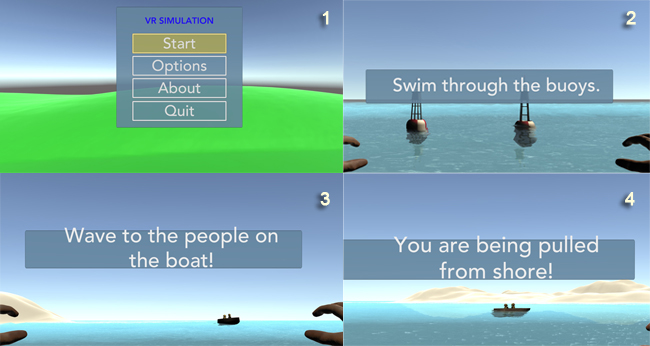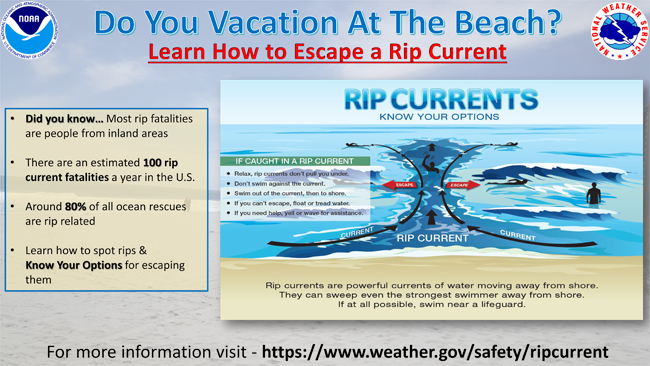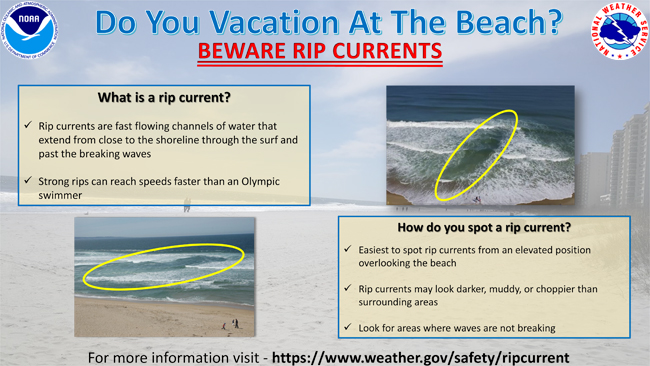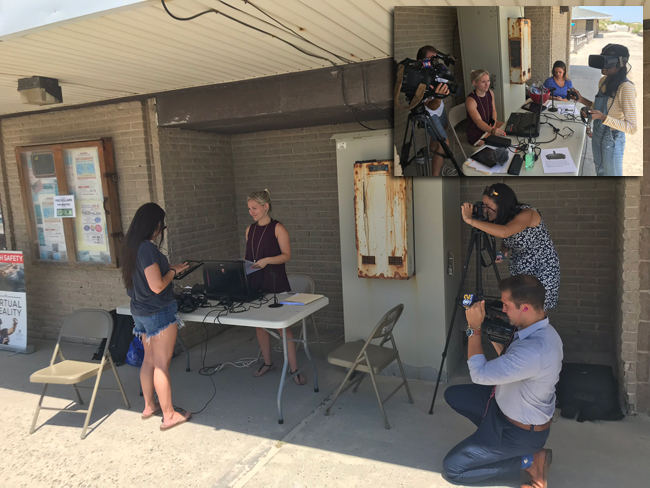
Screen captures from the rip current virtual reality game, which you can play online. Credit: Jase Bernhardt.
— By Chris Gonzales, Freelance Science Writer, New York Sea Grant
Hempstead, NY, May 1, 2021 - A researcher has created a video game simulation to teach beachgoers the hazards of rip currents—narrow channels of fast-moving water that can challenge even skilled swimmers.
Jase Bernhardt, assistant professor in the Department of Geology, Environment and Sustainability at Hofstra University, led the New York Sea Grant (NYSG)-funded research project. He teaches courses in meteorology, climate change, and sustainability at Hofstra.
Rip currents are strong flows of water that can rapidly draw swimmers away from shore. Contrary to a common misperception, they will not pull swimmers underwater directly. However, the dangerous currents may cause swimmers to panic, which can exhaust those inexperienced and lead to their deaths.

Rip currents are strong currents of water moving away from shore. They can sweep even the strongest swimmer away from shore. Source: National Weather Service.
Why create a rip current virtual reality simulation?
According to the National Oceanic and Atmospheric Administration’s National Weather Service, rip currents are among the leading weather hazard fatalities. Seventy-two people were killed by rip currents in the U.S. in 2019. Over a recent 10-year period, an average of 60 people died because of them.
“It is a deadly phenomenon, but easily preventable,” said Bernhardt.
Technically, rip currents are formed by jetties or sandbars that interrupt flows of water. Typically, backflow is created between sandbars that are perpendicular to and leading away from the shore or beach. A rip current is hard to see when you’re in it. However, they are more easily visible from slightly higher up on the beach, where you can see areas of sea without whitecaps or waves. These currents drag swimmers out to sea, away from shore.

Rip currents are easiest to spot from an elevated position. Rip currents may look darker, muddy, or choppier than surrounding water. Look for areas where waves are not breaking. Source: National Weather Service.
Limited understanding
Less than 30% of beachgoers in Texas—where they have a longer beach season than New York—could identify rip currents from pictures.
“If you make a video game, and ask people to get in there, and actually do it, hopefully, the lesson will make a deeper impression,” said Bernhardt.
In the game, players have to escape the rip.
The rip current simulation uses the same type of virtual reality (VR) engine used in mainstream recreational simulation games. The researchers believe VR is a strong teacher; it creates powerful learning experiences.
“By leveraging an innovative technology—a virtual reality video game—we aim to improve public understanding of rip current risk and the proper actions to take if caught in one,” said Bernhardt.
About the Study and Gameplay
Investigators wanted to answer two questions: (1) Will swimmers take the appropriate action? (2) How effective is VR in improving understanding of rip currents? Participant’s understanding and responses were assessed with pre- and post-surveys.
They didn't tell participants they would face a rip current in the game.
They trained them to “swim” by using the controller and watching through the VR goggles.
They also taught them to “wave” for help, deemed an acceptable reaction.
Players were informed they were being pulled from shore as a stamina counter drops from 60. Graphics show them moving away from shore, and when a stamina of 20 or less is reached, they can hear their heavy breathing. If their stamina goes down to zero, the player drowns.
Or they can learn to escape the current.
For more on the news coverage garnered by the Summer 2019 virtual reality experiment, see “Using Virtual Reality to Learn How to Escape a Rip Current.”
What Researchers Have Done
Bernhardt and his team developed a video game simulation and, as seen in the video above filed by Fox5 News from July 2019, recruited 64 individuals at a public beach on Long Island (Town of Hempstead Beach in Point Lookout, NY) to give it a try.
The article available through the Journal of Visualized Experiments (JOVE) includes detailed, step-by-steps to build an exact version of the game the scientists created. There is some coding in C#, but those scripts can be downloaded from an address provided in the article. The scientists have made it as easy as possible for their work to be reproduced.
As CBS 2 News also reported in July 2019, Bernhardt’s project asked beachgoers to swap out their sunglasses for virtual reality headsets while at Hempstead Beach in Point Lookout, NY.

Broadcast journalists (including ones from Fox 5 and CBS 2 News) covered Bernhardt’s work at the beach in July 2019. Credit: Jase Bernhardt.
How Players Responded
Most of the participants felt that the VR helped them feel better prepared for a rip current, particularly because of its realism.
They believed the video game was generally effective at portraying risk. It demonstrated proper actions to take in an engaging and memorable way. It left them feeling more prepared than not. Numerous participants praised the VR for characteristics such as its realism and interactivity.
Future Plans
Bernhardt wants to target future research to reach infrequent swimmers, weaker swimmers, and those who live further away from beach areas. This audience might best benefit from the simulation and training.
“We have posted the game online, making it publicly accessible, which will assist with broader dissemination of the game for both outreach and further surveying,” said Bernhardt.
In this NYSG virtual seminar from July 2020, Dr. Jase Bernhardt discusses the use of virtual reality (VR) to communicate to beachgoers the dangers of rip currents.
References
“If you make a video game, and ask people to get in there, and actually do it, hopefully, the lesson will make a deeper impression,” said Bernhardt. Source: Journal of Visualized Experiments.
More Info: New York Sea Grant
New York Sea Grant (NYSG), a cooperative program of Cornell University
and the State University of New York (SUNY), is one of 34 university-based
programs under the National Oceanic and Atmospheric Administration’s
National Sea Grant College Program.
Since 1971, NYSG has represented a statewide network of integrated
research, education and extension services promoting coastal community
economic vitality, environmental sustainability and citizen awareness
and understanding about the State’s marine and Great Lakes resources.
Through NYSG’s efforts, the combined talents of university scientists
and extension specialists help develop and transfer science-based
information to many coastal user groups—businesses and industries,
federal, state and local government decision-makers and agency managers,
educators, the media and the interested public.
The program maintains Great Lakes offices at Cornell University, SUNY
Buffalo, SUNY Oswego and the Wayne County Cooperative Extension office
in Newark. In the State's marine waters, NYSG has offices at Stony Brook
University in Long Island, Brooklyn College and Cornell Cooperative
Extension in NYC and Kingston in the Hudson Valley.
For updates on Sea Grant activities: www.nyseagrant.org has RSS, Facebook, Twitter, Instagram, and YouTube links. NYSG offers a free e-list sign up via www.nyseagrant.org/nycoastlines for its flagship publication, NY Coastlines/Currents, which is published quarterly.